What’s New
Archives
Our dear friend and colleague Matthew Clinger spent the past year and a half courageously battling extraskeletal osteosarcoma cancer. It is with the utmost sorrow that we share Matt passed away on Wednesday, March 24th. He continued against all odds through extensive chemo and radiation to play a significant role at MHTN as one of our esteemed leaders. We recognize and celebrate the bounty of inspiration, dedication, and innovation that Matt shared with each of us.
Matt will always be known as an expert designer, architect, leader, and mentor. Those skills made him a pleasure to work with, but more so his integrity and remarkable ability to accept things as they are and still spark joy. Matt shared much with us. We have especially benefited from his mentorship and influence in inspiring young professionals at MHTN.
In Matt’s honor, MHTN would like to continue that spirit of mentorship and professional development by instituting the “Matt Clinger Mentoring Grant”, which will be awarded to a recipient at MHTN each year. This will allow our valued employees to experience a more acute focus on education, mentorship, and professional growth and then share what they learn with others.
Our thoughts turn now to Matt’s wife and five children. We thank them for the countless hours they shared Matt that enabled us to stretch further and discover exceptional design solutions. We hold them in our thoughts and ask that they be granted the peace and strength to endure the great loss of their husband and father.
When MHTN was hired to design the new West Bountiful Elementary School, the District asked our design team to create a school that would support learning throughout the building. From this vision stemmed the idea of creating fun space that would inspire learning and creativity. Our team immediately saw an opportunity to go consult with the experts on the matter – the West Bountiful students.
Over the course of several months, MHTN worked with the District and the school administration to engage the students through several creative exercises. The goal of this engagement was to better understand what was important to the students and how that might influence the theming and design of the new school. Through a school wide-writing assignment, the MHTN team saw a common theme of “Imagination” emerge. This theme became the building block for future design discussions.
As a follow up, our design team spent time with small groups of students to explore the idea of imagination and the built environment. Students were asked to picture places where they imagine best. Students created small-scale models highlighting what they felt was important about an imagination space. The models ranged from underwater caves to treetop nests, to desert sanctuaries. These creative explorations provided inspiration for the habitat concepts seen in each of the learning communities. This student engagement directly influenced color selection, graphics, and design implementations throughout the entire school.

One key area where the result of the student engagement activity can be seen is in the “nooks” in each learning community. These spaces became the perfect opportunity for large-scale graphics that built upon whimsical interpretations of the habitat theme. The graphics combine abstraction and realism, out-of-scale and out-of-place elements, human-made objects and nature to create a landscape to spark curiosity. The pixelated edges mirror architectural elements featured throughout the building. The graphics further shape the concept of imagination by obscuring details in a dream-like fashion. These elements are unified through a color palette unique to each habitat, creating an imaginative learning environment for students, teachers, and staff.

Multiple graphics and branding elements were placed throughout the building to stitch together the Imagination concept. Additionally, a space located on the second level is dedicated as an “Imaginarium.” This unique makerspace looks directly into the multipurpose area and offers a flexible environment for students to explore and create. Spaces like this showcase the potential of looking outside the box for creative influences during a design process. West Bountiful Elementary stands as an example that student led-imagination can lead to exciting and creative spaces for new K-12 projects.
To learn more about the full project, click here: West Bountiful Elementary School
Knowing that our office lease was going to be up in 2021, MHTN’s Pre-Design Team guided MHTN through a visioning and programming process to help imagine what the future of MHTN’s offices could be.
Faced with a looming lease-renewal and the choice to either stay and remodel our current space or move into a new space, MHTN wanted to know “How can we re-imagine our workspace?” With the expertise of our in-house Pre-Design Team, we embarked on an office-wide visioning and programming process that engaged and inspired our staff, evaluated challenges, and ultimately led to some wonderful ideas and unexpected insights.
Little did we know at the time what 2020 would bring. Those early exercises, in the Fall of 2019, led to a program for a future office space that is supportive of well-being, collaboration, and a variety of work modes. An office that supports human needs (physical, emotional, cognitive, and social) and the ways that we work.
As COVID-19 hit and everyone shifted to working from home, our team reviewed and revisited the program to find that it aligned with all that we’ve learned from this pandemic about the future of work and the workplace.
VISION 2021
As architects and designers, we eat, breath, and sleep conceptualizing space. How it functions and supports human needs, how to make it aesthetically pleasing. When it comes to our own office, everyone has their own way of working, organizing their workspace, and approaching creativity. As the Pre-Design Team got to work, a main challenge was in getting employees and leadership to step away from their existing mode of operation and evaluate their work process. We used a variety of exercises to get staff to ask themselves these questions:
In the future, when the vision of our future office has come to life, what will the experience be like?
What is an “ideal office”, and how does it support our employees, culture, and work as creative professionals?
When tasked with re-imaging something that is so close to our own experience, we almost needed an “intervention” to get a group of architects to avoid jumping to spatial conclusions, and instead, think about how we see ourselves, and how we envision the culture we want to cultivate in a new space.
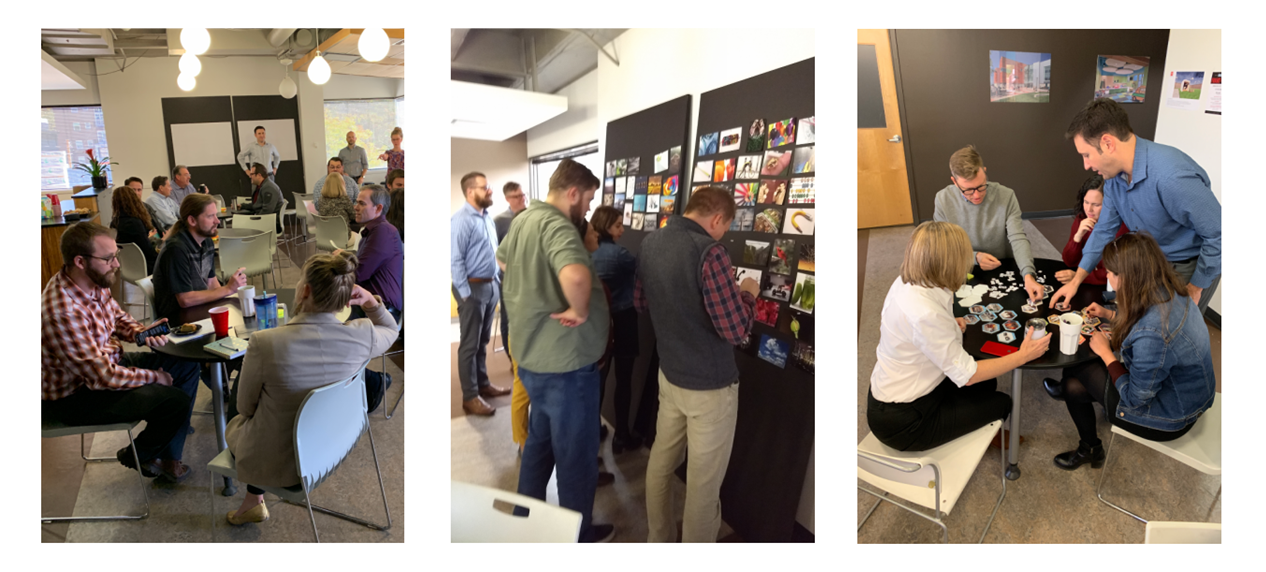
The Pre-Design Team crafted a series of interactive workshops, surveys, pin-ups, focus groups, and even invented a board game, to address a few fundamental topics: workplace culture, the relationship between focused work and creative collaboration, and how our context and environment contribute to a sense of well-being. Common themes began to emerge, and we developed a set of project drivers that became our VISION 2021 Program that ultimately informed the design of the new studio:
• Support the individual within the collective • Honor roots, nurture growth
• Exploration and creation • Fostering wellness • Space that inspires • Embedded resiliency
A SHIFTING LENS
And then, COVID-19. As the pandemic unfolded and we scattered into our remote worlds, our team immediately began to wonder if our visioning and programming findings were still valid, do people still want these things. In response, MHTN circled back with follow-up surveys. The team engaged a subsequent workshop to understand “what is the future of work?” and “how can we as design professionals enhance the inherently-collaborative work we do?”
Turns out, despite the radical change and efficiencies found in remote work, our employees tracked with the nation. We found our firm values an even balance of collaboration, professional resources, and focus while inside the office. It also became apparent there is a consensus in placing greater emphasis on teamwork. These findings inspired us to think about our future office space in a totally new way: that it can be a place we go to exchange ideas, test, and discover new things together, and that maybe it shouldn’t be called an office anymore, but instead we should call it our “studio.”
A few surprising bits were uncovered in this process. One, the engagement of 100% of staff was off the charts and continues to this day. The experience validated the theory that bringing more people into the conversation activates a sense of belonging and comradery, that helps create a culture we will all thrive in. And two, this experience reinforces the importance of going through a visioning exercise.
Lastly, the visioning that MHTN does with our clients has prompted epiphanies and “a-ha” moments. We found, though, it can be difficult to understand the profound results until you go through it with your own colleagues, there is power in imagining together.
The new Academic Building at Utah State University Moab will be the most sustainable building on any USU learning campus. Currently under construction, the combustion-free and all-electric facility is designed for LEED Silver Certification and Zero Energy Certification standards by the International Living Future Institute.
A photovoltaic array not only powers the entire building but doubles as shading structures for parked vehicles, mitigating excess heat in the summer peak. The landscape design will utilize water-wise rain-harvesting strategies in addition to showcasing a permaculture garden. Ground-source technology leverages the stable temperature of the earth to heat and cool the building. Locally-sourced and non-toxic, Red-List free interior finishes create a healthy atmosphere for students and faculty.
Responsive to its context on the Colorado Plateau, the new Academic Building is integrated into the landscape. Passively designed to capture views to the Moab Rim and La Sal Mountains, the design will harness the abundant solar energy available on the site. Deep roof overhangs create a series of outdoor covered porches allowing for the wide variety of classes to spill outside. Together with our sustainability partner, Lake|Flato, the project incorporates biophilic design strategies into the building such as natural daylighting and views to the surrounding landscape. These strategies also include natural materials, patterns, textures, and colors in the exterior and interior, helping to bring the outdoors inside.
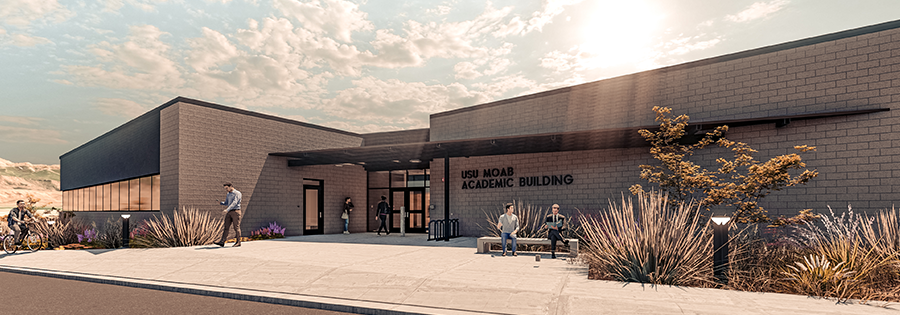
Read more about the Academic Building at Utah State University Moab: www.mhtn.com/usu-moab
The new Dixie State Human Performance Center is an innovative combination of three major campus functions: academic, recreation and athletics. An iconic landmark serving as a gateway for the west entry of campus, the new center resides in rich surroundings and a unique and inspiring landscape. Dramatic horizons in all directions, vistas across the city to surrounding mesas and the favorable year-round climate all distinguishes DSU from all other universities in the state. As is evident by the surrounding environment of the campus, it is very fitting to punctuate DSU’s mantra “active learning/active life” with this new landmark building that will be one of the most prominent in the region.
With these powerful elements of regional context and campus influences, our team, in conjunction with the Steering Committee, shaped the aesthetic of the new Human Performance Center. Key features incorporated in the building include: Spaces filled with natural light, visibility into activity areas and the surrounding campus, public lounges, and activity zones that provide opportunities for learning and hands-on training. With its corner prominence, the Olympic-size pool and indoor climbing wall are significant differentiators that will be showcased to the campus and surrounding community. Utilizing the rooftop, DSU will be able to take advantage of the favorable southern Utah climate, and expand its recreational offerings to its students, faculty and staff. These unique spaces will include a rooftop running track, outdoor athletic courts, inclined “Sprint Hill”, outdoor fitness balconies, gathering spaces and entry plaza.
Our design team was tasked to design “the best facility in the state” to house academic, athletic and recreation departments under one roof in a cohesive and unifying manner. As a hub for student activities and academics, the Center will play a major role in recruitment and retention of students and faculty, not only within the health and exercise programs, but those interested in intramural sports and an active student life experience.
Sustainable design solutions accomplished in the project include a high-performance building envelope to provide maximum energy efficiency, complying with Utah’s strict requirements including a 20 percent energy cost enhancement of energy performance and an air leakage rate of .1 cubic feet per minute or less at the building envelope.
Read more about the full project here: www.mhtn.com/dsu-human-performance/
With you, MHTN Architects stands in solidarity against systemic racism. We commit action in our day-to-day practice, voices, and simple human interactions to design and plan together to end institutional injustice and create real positive change. We’re listening and we’re committed to do our part in making a more just world.
June 5th, 2020
Dear MHTN:
Current events in our nation warrant MHTN Architects to stand in solidarity against systemic racism. We live in a state that is a racial/cultural bubble, where only 1.5% of our community identifies as black, 81% as white, and only 17.5% other races. This fact makes positive impact a challenge, but it does not mean we are relegated to passively watch how others move the needle.
Sadly motivated by tragic events, today it is imperative that we pledge action in our day-to-day practice, voices, and simple human interactions to design and plan together to end institutional injustice and create positive real change. This is a moment for the design industry, as a whole, to commit to a better future, and for MHTN to join other national architecture firms in taking proactive steps to do so.
In expressing our solidarity, we must be sincere and respect what our peers at the National Organization of Minority Architects are saying:
“…architects who expressed solidarity need to back it up with action, according to the National Organization of Minority Architects (NOMA) in its own statement this week. Founded in 1971 by 12 black architects in Detroit, the organization grew out of the Civil Rights era and has long been a resource for best practices in minimizing the effects of racism on the profession. There is no more authoritative voice than NOMA on how non-black architects should help.”
– from Dear White Architects, Be B.R.A.V.E. Not Sad. Love, NOMA, Metropolis Magazine
With this letter, we want to recommit and amplify MHTN’s Firm Value of Social & Environmental Responsibility: recognizing our connection to this world – its inhabitants and natural environment.
We are asking your support to follow through and improve our awareness and positive impact, tangibly, together. Here is what we have started:
- UU Community Partners Scholarship – MHTN was first in the field of architecture to support the University of Utah’s Community Partners Scholarship. The program pairs a student, in an underrepresented demographic, with a community mentor to ensure the completion of their degree. This enables a mentor relationship for someone who has few role models in their community. We are in our 6th year of this program. Support of and Cultural Lessons from North Carolina Central University -design and workshops to enable the possibility of their new Student Union at this HBCU.
- Diversity Advocates – Associate Principal Randy Knight is Co-Presenter at ACUI on Diversity in the Student Union.
- Design of the Meditation Space and Inclusive Restrooms at the University of Utah Olpin Union.
- Volunteers of America Homeless Youth Center- Design for empowerment of one of Salt Lake City’s underserved communities.
- 2019 introduction of United Way charity portal allowing each employee to individually select meaningful organizations for which they would like to donate.
- Women In Design – founded 2019 with the mission to recruit, retain, and advance women professionals in architecture and the design professions, and widen the broader inclusion discussion.
- Diversity and Inclusion – the 2020 MHTN Board of Directors is in the process of defining this role for the firm.
- Implicit Bias Training 2020 – MHTN will conduct this training when the right leader consultant is found.
- Pursue JUST Certification
It begins with awareness of ourselves and how we can flip problematic patterns, including our own passivity. We have work to do, we will report progress as we go – and this is just a start. Thank you for committing, MHTN, as we move forward.
Sincerely,
President
CEO
MHTN Architects is closely monitoring the situation with COVID-19 and making preparations to ensure seamless continued service of our projects in the event of a quarantine. It is our goal to provide the same attention and high-level of care you have come to expect from MHTN. Additionally, to ensure the health and well-being of our staff and surrounding communities, we have decided to suspend business air travel until April 30th, and then we will reassess. Fortunately, we are prepared with the latest technologies allowing our staff to produce design deliverables and collaborate effectively with you, and with each other, while working remotely.
Between the technologies we employ and the commitment of our professional and administrative staff, MHTN anticipates being able to meet all project deadlines and expectations during this time.
Thank you for your continued support of MHTN Architects!
Millcreek’s inaugural City Center Master Plan is a transformative vision for the district between Highland Drive to 1300 East and 3300 South to Elgin Avenue. It imagines the approximately 100-acre area as a lively, vibrant, walkable, and identifiable City Center that is inspired by the City’s values and unique setting in the Salt Lake Valley. Building upon the recently adopted general plan, the Master Plan reflects the City’s active “Connected by Nature” theme.
Creating the Plan involved extensive public engagement. MHTN Architects + VODA Landscape Architecture and Planning and Millcreek City Staff hosted two walking tours of other successful nearby city centers: one in Salt Lake City’s Sugar House neighborhood, and another in Holladay’s recently revitalized downtown. On both tours, the facilitators led residents through popular and lively parts of each neighborhood demonstrating different urban design and placemaking strategies at work. In addition, three public open houses drew in residents and small business owners to provide feedback and comments on various iterations of the Plan.
The Plan follows several key guiding principles. First, the design of Millcreek’s City Center should represent the City in ways that are distinct from other cities. Second, the City Center should emphasize walkability and minimize internal traffic and parking demand. Third, the City Center should include municipal property owned by the City and designated for public use. Fourth, the City Center should emphasize culture, art, ideas, and interaction between citizens.
Three distinct districts make up the City Center. The City Marketplace, encompassing the area mostly to the south of 3300 South and partially to the east of Highland, is a significant gateway into the City Center and an active shopping zone. The plan envisions improved urban design in the form of infill development, buildings with smaller footprints, decreased setbacks, hidden parking, and increased pedestrian pathways between stores. The central district is the Millcreek Center, the Plan’s main focal point and home to the expansive Mill Park. Mill Park is a multifaceted open space full that includes bucolic lawns for quiet, reflective uses like walking and conversing. Other placemaking elements include activity zones for splash pads, bouldering, tot lots, sand pits, and playground equipment; a civic zone for community uses such as farmers markets, concerts, and other large-scale outdoor events; and a prominent transit stop with a large monument sign providing visitors a sense of arrival. The third district comprising the area from Elgin Ave to Miller Ave is the Neighborhood District, which intends to transition gradually between the scale of the City Center to the existing single-family homes nearby.
Overall, the Plan emphasizes urban design, placemaking, and connectivity to improve the pedestrian and bicycle experience. People-oriented laneways, a woonerf, and a one-way couplet street are unique elements to the plan and serve to make the City Center more walkable. The introduction of boulevards, bike lanes, and on-street parking consider multimodal access to the Center. Connections to regional trails are also integral to the plan to ensure active transportation access to the Center. Recommendations for existing road right-of-way rebalancing is provided within the plan to establish complete streets at the City Center to enhance access by people walking, biking and riding public transportation.
To ensure the Plan is implementable, economic development strategies as well as phasing and implementation recommendations are provided. Strategies to assist the City in working with developers on achieving a cohesive City Center are provided. Additional elements of the plan included to assist in implementation include urban design guidelines, landscape recommendations, building form guidelines to support a form-based code approach, and transportation recommendations.
Before and After. Great design has the power to transform. University campus buildings can be resilient, and this is a fantastic example. Imagine inhabiting a sloped roof office space. Not very workable! This Southern Utah University remodel changes a 1978 exterior (a former solar collector for a swimming pool) into an energy efficient contemporary facade. We cut off the cantilever to increase usable floor area, and created a new facade that faces the main quad. The countdown is on for the ribbon cutting and grand opening May 2nd, which will activate the new main entry and prominent two-story glass volume displaying a cast of a fossilized dinosaur skeleton found in quarries nearby.
On November 9th, the new Carolyn and Kem Gardner Commons celebrated its dedication as the University of Utah’s premiere example of interdisciplinary undergraduate academics. MHTN Architects’ design addresses the U of U’s goal of a holistic academic environment that builds student community, by strategic proximities and detailed settings that invite students in a relaxed and collegial student environment.
At five stories tall, the long building sits composed in balance. Its lifted façade anchors and engages the Piazza-Navona-scaled Marriott Library Plaza. Highly transparent, and tall, levels 1&2 invite students from all directions, and establish a cadence of outdoor seating areas, elevated around Tanner Fountain.
The new building replaces and upgrades the legacy function of its predecessor, Orson Spencer Hall, as the primary classroom resource to the undergraduate campus. It performs at PAC 12 norms, and is used by some 20,000 students each year, and by over 60 different departments that schedule classes here. The building incorporates 37 classrooms, collaborative space, research space, and 177 faculty offices.
As a central hub for daily undergraduate life, Gardner Commons is the new home for College of Social & Behavioral Sciences, 15 departments and Institutes, including the Hinckley Institute of Politics, as well as a consolidated center for Advising, a prominently located University Welcome Center, and 150-seat Café/Study zone on the main level with 4 food venues, and integrated study lounge seating.
On upper levels, intentional placement of research programs, faculty departments, specialty labs, and social resources, sit directly across from classrooms where required classes are scheduled. Undergrads deciding on a major are able to see into programs and resources they may not otherwise consider during the first critical years at college.
With the repetitive rigor of lab procedure, three simple clerestory incisions inject light into the center spine of the building. The experience of each clerestory, more a nod to the behavioral sciences, becomes a sculptural point of confluence, encouraging social interaction on the top levels of the building. Play of sunlight and shadow naturally draws people to places to sit, study, or meet others between class, programs, and workspace destinations.
Gardner Commons is the first building at the University of Utah to use Ground Source Wells as its heating and cooling energy source. They provide 96% of the heating loads (or 100% heating hours), 60% of the cooling load (or 90% cooling hours). The System savings over typical campus systems is $70,000 annual energy savings. This approach is removes 378 metric tons of CO2 Eq from campus, and makes the building carbon-neutral-ready.
MHTN’s design of this building is innovative and influential in assisting the University to rewrite campus standards, spending less dollars per square foot than its predecessors, while bringing long term value.
Learn more on YouTube watch Gardner Commons at the University of Utah

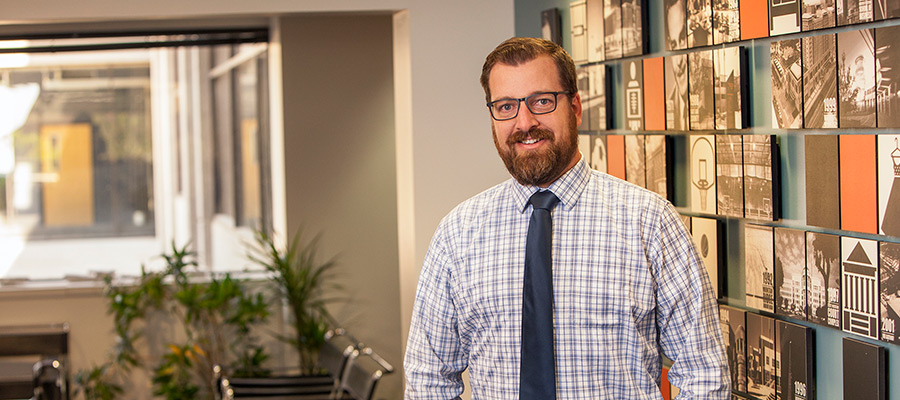
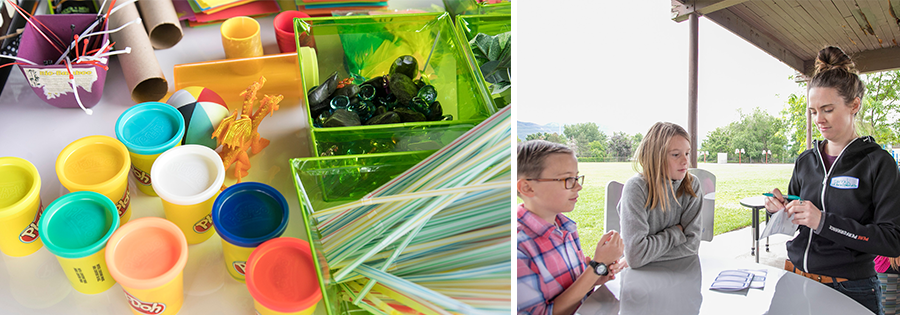

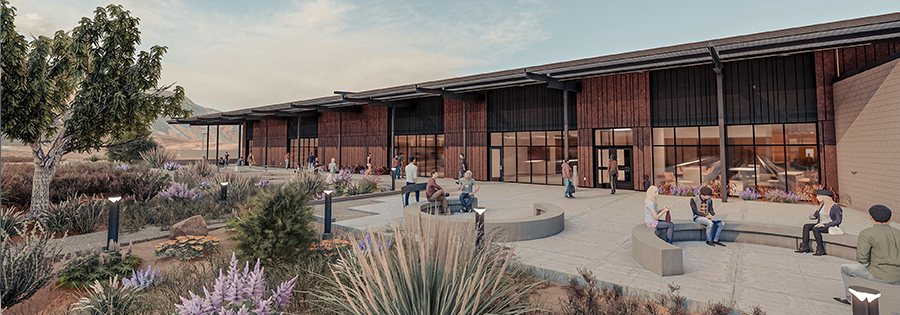
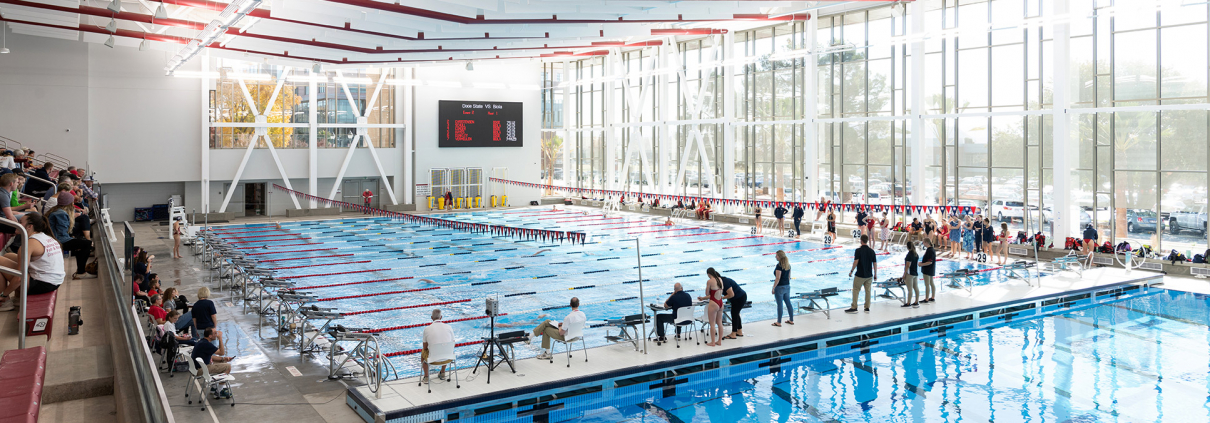
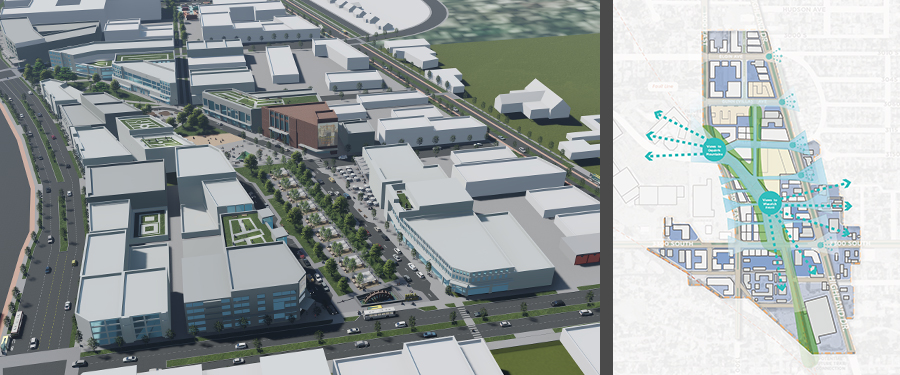
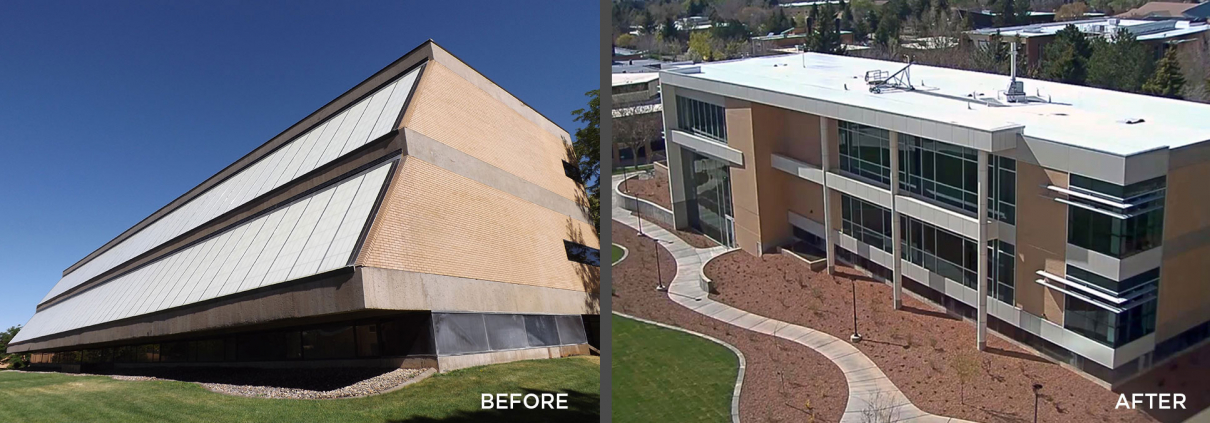
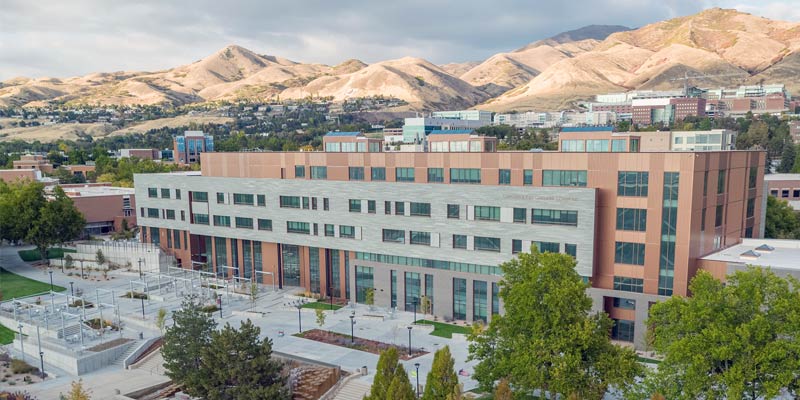 MHTN
MHTN
Myriad Genetics Inaugurates West Campus